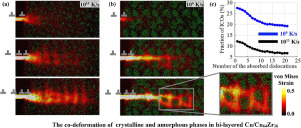当前位置:
X-MOL 学术
›
Acta Mater.
›
论文详情
Our official English website, www.x-mol.net, welcomes your feedback! (Note: you will need to create a separate account there.)
Metallic Glass Instability Induced by the Continuous Dislocation Absorption at an Amorphous/Crystalline Interface
Acta Materialia ( IF 9.4 ) Pub Date : 2020-05-01 , DOI: 10.1016/j.actamat.2020.02.038 Thanh Phan , Ji Rigelesaiyin , Youping Chen , Ashraf Bastawros , Liming Xiong
Acta Materialia ( IF 9.4 ) Pub Date : 2020-05-01 , DOI: 10.1016/j.actamat.2020.02.038 Thanh Phan , Ji Rigelesaiyin , Youping Chen , Ashraf Bastawros , Liming Xiong

|
Abstract An amorphous/crystalline metallic composite (A/C-MC) integrates metallic glass with crystalline metals in one system. The amorphous-crystalline interface (ACI) in A/C-MCs under deformation absorbs dislocations and may fundamentally change the dilemma that the strength comes at the expense of the ductility of a material. However, the development of such materials is still at a trial and error stage due to the lack of a clear-cut understanding on how the amorphous component become instable when a dislocation-mediated plasticity flows into the glassy phases. To meet this need, here we focus on gaining the physical insights into the dislocation-ACI reaction in A/C-MCs through atomistic simulations. We have (i) digitally resembled an interface structure close to that in experiments by annealing melted metallic glasses at cooling rates as low as ∼ 104 K/s; (ii) correlated the dislocation absorption events with the activation of shear transformation zones (STZs) in A/C-MCs under a plastic shear; (iii) identified the mechanisms responsible for a continuous dislocation absorption-induced instability in glassy phases; (iv) calibrated a set of constitutive relations, kinetic rules, and model parameters that can be used in an effective temperature concept-based STZ theories at the continuum level; and (v) characterized the local stress states ahead of the instability band and lay the macroscopic-level glass instability criterion on a firm atomistic basis. Our major findings are: (a) there exists a nanoscale structure transition at the ACI when the cooling rate in the atomistic simulations is reduced to an experimentally-comparable level; (b) the number of atoms participating in the STZs exponentially increases with the number of dislocations arriving at the ACI at an early stage of the dislocation-ACI reaction, but is linearly proportional to the number of absorbed dislocations at a later stage; (c) the dislocation absorption-induced instability in metallic glasses occurs through a three-stage process, i.e., the activation of STZs in the region between icosahedral (ICO) clusters, the coalescence of newly formed STZs, and then the breakdown of ICOs; (d) the model parameters in the continuum-level constitutive relations and kinetic rules are found to be sensitive to cooling rates; and (e) the local stress states ahead of the instability band in glassy phases map surprisingly well with the Mohr-Coulomb criterion regardless of the applied stress at the macroscopic level. The gained knowledge may provide a pathway of connecting the atomistic deformation physics of an A/C-MC with its overall mechanical performance, which is currently difficult to achieve in laboratory experiments.
中文翻译:

非晶/结晶界面处连续位错吸收引起的金属玻璃不稳定性
摘要 一种非晶/结晶金属复合材料 (A/C-MC) 将金属玻璃与结晶金属集成在一个系统中。变形下的 A/C-MC 中的非晶-结晶界面 (ACI) 吸收了位错,并可能从根本上改变强度以牺牲材料延展性为代价的困境。然而,由于对位错介导的塑性流入玻璃相时非晶组分如何变得不稳定缺乏明确的理解,因此此类材料的开发仍处于试错阶段。为了满足这一需求,我们在这里专注于通过原子模拟获得对 A/C-MC 中位错-ACI 反应的物理见解。我们已经(i)通过以低至约 104 K/s 的冷却速率对熔化的金属玻璃进行退火,在数字上模拟了接近于实验中的界面结构;(ii) 将位错吸收事件与塑性剪切下 A/C-MC 中剪切转变区 (STZ) 的激活相关联;(iii) 确定了导致玻璃相中连续位错吸收引起的不稳定性的机制;(iv) 校准了一组本构关系、动力学规则和模型参数,这些参数可用于连续介质级别的基于温度概念的有效 STZ 理论;(v) 表征不稳定带之前的局部应力状态,并在牢固的原子基础上建立宏观水平的玻璃不稳定标准。我们的主要发现是:(a) 当原子模拟中的冷却速率降低到实验可比的水平时,ACI 处存在纳米级结构转变;(b) 在位错-ACI 反应的早期,参与 STZ 的原子数量随着到达 ACI 的位错数量呈指数增加,但与后期吸收的位错数量成线性比例;(c) 金属玻璃中位错吸收引起的不稳定性通过三个阶段的过程发生,即二十面体 (ICO) 簇之间区域的 STZ 的激活、新形成的 STZ 的合并,然后 ICO 的分解;(d) 发现连续体级本构关系和动力学规则中的模型参数对冷却速率很敏感;(e) 玻璃相中不稳定带之前的局部应力状态与 Mohr-Coulomb 准则的映射出奇地好,而不管在宏观水平上施加的应力如何。所获得的知识可以提供一种将 A/C-MC 的原子变形物理与其整体机械性能联系起来的途径,这目前在实验室实验中很难实现。
更新日期:2020-05-01
中文翻译:

非晶/结晶界面处连续位错吸收引起的金属玻璃不稳定性
摘要 一种非晶/结晶金属复合材料 (A/C-MC) 将金属玻璃与结晶金属集成在一个系统中。变形下的 A/C-MC 中的非晶-结晶界面 (ACI) 吸收了位错,并可能从根本上改变强度以牺牲材料延展性为代价的困境。然而,由于对位错介导的塑性流入玻璃相时非晶组分如何变得不稳定缺乏明确的理解,因此此类材料的开发仍处于试错阶段。为了满足这一需求,我们在这里专注于通过原子模拟获得对 A/C-MC 中位错-ACI 反应的物理见解。我们已经(i)通过以低至约 104 K/s 的冷却速率对熔化的金属玻璃进行退火,在数字上模拟了接近于实验中的界面结构;(ii) 将位错吸收事件与塑性剪切下 A/C-MC 中剪切转变区 (STZ) 的激活相关联;(iii) 确定了导致玻璃相中连续位错吸收引起的不稳定性的机制;(iv) 校准了一组本构关系、动力学规则和模型参数,这些参数可用于连续介质级别的基于温度概念的有效 STZ 理论;(v) 表征不稳定带之前的局部应力状态,并在牢固的原子基础上建立宏观水平的玻璃不稳定标准。我们的主要发现是:(a) 当原子模拟中的冷却速率降低到实验可比的水平时,ACI 处存在纳米级结构转变;(b) 在位错-ACI 反应的早期,参与 STZ 的原子数量随着到达 ACI 的位错数量呈指数增加,但与后期吸收的位错数量成线性比例;(c) 金属玻璃中位错吸收引起的不稳定性通过三个阶段的过程发生,即二十面体 (ICO) 簇之间区域的 STZ 的激活、新形成的 STZ 的合并,然后 ICO 的分解;(d) 发现连续体级本构关系和动力学规则中的模型参数对冷却速率很敏感;(e) 玻璃相中不稳定带之前的局部应力状态与 Mohr-Coulomb 准则的映射出奇地好,而不管在宏观水平上施加的应力如何。所获得的知识可以提供一种将 A/C-MC 的原子变形物理与其整体机械性能联系起来的途径,这目前在实验室实验中很难实现。



























 京公网安备 11010802027423号
京公网安备 11010802027423号